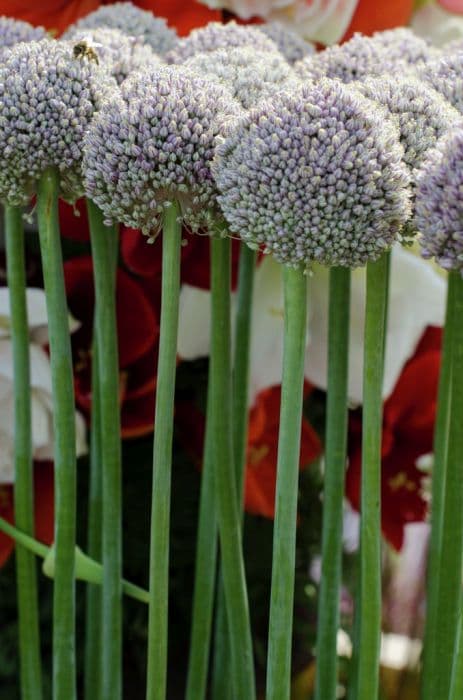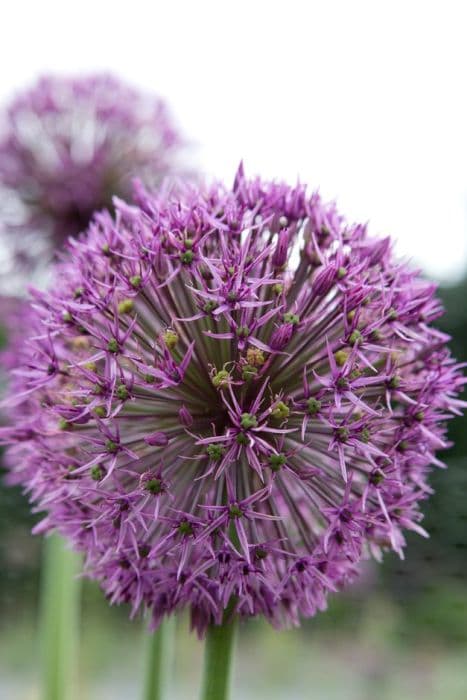Sky Blue Allium Allium caesium

ABOUT
Allium caesium, commonly known as the blue globe onion, is a perennial plant that is best recognized for its striking spherical clusters of flowers. The flowers themselves boast a delicate blue to purple hue, forming tight, globular heads that nod elegantly on top of sturdy, upright stems. The foliage of the blue globe onion consists of slender, grass-like leaves that emerge from the base of the stem, presenting a rich green color that contrasts nicely with the bluish-purple flowers. The leaves are typically long and narrow with a slightly glossy surface and can create a lush, tufted mound at the plant's base. The overall form of the plant is rounded with a tidy, clumping habit.
About this plant
 Names
NamesFamily
Amaryllidaceae
Synonyms
Ornamental Onion, Sky Blue Allium
Common names
Allium caesium.
 Toxicity
ToxicityTo humans
Allium caesium, commonly known as ornamental onion, is not generally considered toxic to humans. As a member of the Allium family, it is related to edible species like onions and garlic, but it is important to note that some individuals might be sensitive or allergic to Allium species. If a person ingests a large quantity or has a sensitivity, they could potentially experience digestive discomfort, such as stomach pain, nausea, vomiting, or diarrhea.
To pets
Ornamental onion (Allium caesium) can be toxic to pets, especially cats and dogs. Allium species contain compounds that can cause oxidative damage to red blood cells if ingested in significant amounts, leading to symptoms such as vomiting, diarrhea, abdominal pain, loss of appetite, and in severe cases, hemolytic anemia which may manifest as lethargy, pale gums, rapid breathing, or ataxia (loss of coordination). If you suspect your pet has ingested any part of the plant, it is important to seek veterinary care immediately.
 Characteristics
CharacteristicsLife cycle
Perennials
Foliage type
Deciduous
Color of leaves
Blue-green
Flower color
Blue
Height
1-2 feet (30-60 cm)
Spread
0.5-1 feet (15-30 cm)
Plant type
Bulb
Hardiness zones
4
Native area
Central Asia
Benefits
 General Benefits
General Benefits- Ornamental Value: Allium caesium, commonly known as ornamental onion, adds aesthetic appeal to gardens with its spherical blue to purple flowers.
- Low Maintenance: Once established, it requires minimal care, making it suitable for gardeners of all skill levels.
- Drought Tolerance: The plant is relatively drought-resistant, which is beneficial for water conservation in landscaping.
- Pest Resistance: Allium caesium has natural compounds that tend to repel many insects, reducing the need for pesticides.
- Deer and Rodent Repellent: Its scent and taste are not appealing to deer and rodents, protecting other plants in the vicinity.
- Attracts Pollinators: The blooms are attractive to bees, butterflies, and other pollinating insects, promoting biodiversity.
- Culinary Uses: Parts of the plant are edible and used in cooking for their onion-like flavor, enhancing culinary diversity.
- Companion Planting: It can be used in companion planting to benefit surrounding plants through pest deterrence and attraction of beneficial insects.
 Medical Properties
Medical Properties- Antioxidant activity: Allium caesium may possess antioxidant properties due to the presence of compounds like flavonoids and sulfur-containing compounds.
- Antimicrobial effects: Some Allium species have been found to exhibit antibacterial and antifungal activities, which might extend to Allium caesium as well.
- Cardiovascular health: As with other Allium species, Allium caesium might have a beneficial impact on heart health by helping to regulate blood pressure and cholesterol levels.
 Air-purifying Qualities
Air-purifying QualitiesThis plant is not specifically known for air purifying qualities.
 Other Uses
Other Uses- Allium caesium, commonly known as Blue Globe Onion, can be used to create a natural dye. The plant's tissue can provide a colorant for textiles and crafts.
- Due to its unique blue flowers, the Blue Globe Onion can serve as an educational tool in botanical studies to observe the characteristics of the Allium genus.
- In some cultures, Blue Globe Onion may be used as a companion plant amid crops to deter rodents and deer, thanks to its strong scent.
- The dried flowers of the Blue Globe Onion can be incorporated into decorative arrangements and potpourri mixtures for a rural aesthetic touch.
- The seeds of the Blue Globe Onion can be collected and used to naturally repopulate areas where native alliums have decreased, promoting biodiversity.
- Blue Globe Onion may be planted in domestic gardens as ornamental plants to attract pollinators like bees and butterflies.
- The sturdy stems of Blue Globe Onion, when dried, can be used in craft projects, including the making of wreaths and other dried floral displays.
- Photographers may use Blue Globe Onion plants as a subject for nature photography because of its striking blue flower heads.
- The plant can be used in culinary education to teach about edible non-conventional plant parts such as bulbs, flowers, and stalks.
- As part of a wildlife-friendly garden, the Blue Globe Onion can offer nectar-rich flowers to support the diet of nectar-feeding insects.
Interesting Facts
 Feng Shui
Feng ShuiThe Allium caesium, commonly known as Blue Globe Onion, is not used in Feng Shui practice.
 Zodiac Sign Compitability
Zodiac Sign CompitabilityThe Blue Globe Onion is not used in astrology practice.
 Plant Symbolism
Plant Symbolism- Unity: Allium caesium, commonly known as ornamental onion, features spherical clusters of flowers that can symbolize unity and togetherness due to their compact and rounded shape.
- Patience: As a plant that can take a while to bloom, the ornamental onion is often associated with patience, reflecting the time and care needed to see its flowers emerge.
- Prosperity and abundance: The abundant blossoms and the spherical shape, reminiscent of a full coin purse, often lead the ornamental onion to be tied to notions of prosperity and abundance.
- Protection: Historically, alliums have been believed to have protective properties, warding off evil spirits and bad luck, and Allium caesium, given its strong scent and robust nature, is no exception.
- Good fortune: In some cultures, the ornamental onion may carry meanings of good fortune and luck, reflecting the belief in its ability to ward off negative influences.
 Water
WaterThe ornamental onion, or Allium caesium, prefers to be watered thoroughly, allowing the soil to dry out slightly between waterings. During the growing season, water the plant every week with about 1 gallon of water per square foot, decreasing to once every two weeks or less during dormancy. Adjust the watering frequency based on rainfall and temperature; more water may be needed in hot, dry weather and less during cool, damp conditions. It is essential to avoid waterlogging as this can cause bulb rot in Alliums.
 Light
LightThe ornamental onion thrives best in full sunlight conditions. It should be planted in a spot where it can receive at least 6 to 8 hours of direct sunlight each day. Areas that provide morning sun and afternoon shade can also be suitable, as long as the plant receives ample light for vigorous growth.
 Temperature
TemperatureOrnamental onions prefer temperatures that range between 55°F and 75°F. They can survive minimum temperatures down to around 28°F, making them suitable for many temperate climates. The maximum temperature tolerance is approximately 90°F, beyond which the plant may start to experience heat stress, so partial shade can be beneficial in hotter climates.
 Pruning
PruningPruning ornamental onions is mainly done to remove spent flower stems to maintain a clean appearance and prevent self-seeding, if desired. Cut back the flowering stems to the ground level after the blooms have faded and the seeds have dispersed. This typically occurs in late summer or early fall. Regular pruning is not necessary unless the plant becomes untidy.
 Cleaning
CleaningAs needed
 Soil
SoilFor the ornamental onion (Allium caesium), the best soil mix is well-draining with plenty of organic matter, such as a blend of loam, sand, and compost. The ideal pH for this plant is mildly alkaline, ranging between 7.0 to 8.0.
 Repotting
RepottingOrnamental onions need to be repotted every few years or when they become overcrowded. Generally, this plant should be repotted every 2 to 3 years to ensure optimal growth.
 Humidity & Misting
Humidity & MistingOrnamental onions prefer a dry to moderate humidity environment and do not require high humidity levels to thrive.
 Suitable locations
Suitable locationsIndoor
Grow in well-lit area & use well-draining soil.
Outdoor
Plant in full sun, well-drained soil.
Hardiness zone
4-8 USDA
 Life cycle
Life cycleAllium caesium, commonly known as sky blue onion, begins its life cycle as a seed that germinates in the soil when conditions are appropriate, usually in spring. The seed develops into a small seedling with a bulb at its base, which then grows leaves and a root system. As it matures, the sky blue onion produces a stalk and an umbel of attractive blue flowers, typically in the early to mid-summer. Following pollination, which is often aided by insects, the flowers develop into seed capsules containing seeds. Once the seeds mature, they are dispersed by wind or other means, and the parent plant's foliage dies back, leaving the bulb dormant underground during the winter. The cycle resumes the next growing season when environmental conditions become favorable for growth, and the bulb sends up new shoots to start the process anew.
 Propogation
PropogationPropogation time
Spring
The most popular method of propagating Allium caesium, commonly known as Ornamental Onion, is through division. This is typically done in the fall, after the leaves have died back or in early spring before growth resumes. Gardeners dig up the bulbs and gently separate them, making sure that each new section has at least one growth point or shoot. These new bulb clusters are then immediately replanted at the same depth they were growing previously, which is usually about 2 to 4 inches (5 to 10 centimeters) deep depending on the size of the bulbs, and spaced approximately 8 to 12 inches (20 to 30 centimeters) apart to allow for adequate room for growth. Adequate watering after replanting is essential to help establish the new plants.









